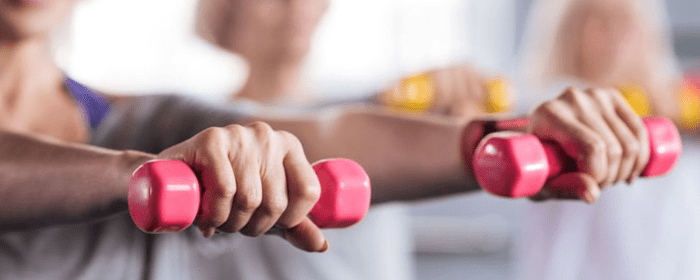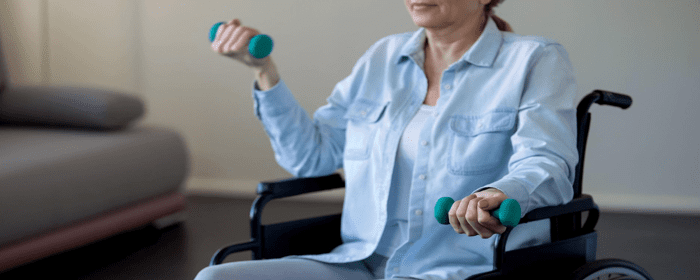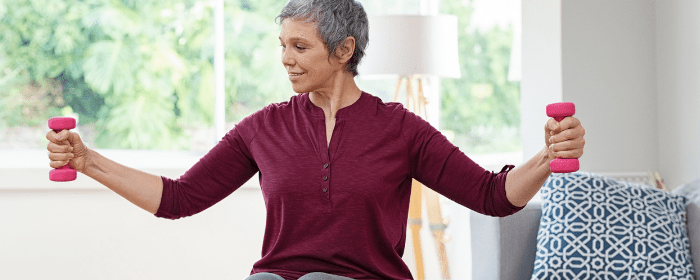
by admin | May 12, 2023 | Health Awareness, Parkinson's Disease
Exercise and a healthy diet are two of the most potent treatments for Parkinson’s disease. Many people who live with Parkinson’s find that positive lifestyle changes slow the condition’s progression and give them better control over their symptoms.
Exercise and Parkinson’s Disease
Exercise is universally beneficial and can improve anyone’s overall health. However, those with Parkinson’s might discover these specific benefits:
- Preventing or slowing the disease’s progression
- Improving brain health
- Reducing symptoms like loss of balance or constipation
- Avoiding isolation
Nobody should have to slog through a workout they hate. Fortunately, all forms of exercise can benefit those with Parkinson’s. The best physical activities are the ones you enjoy — as long as your healthcare provider approves.
Diet and Parkinson’s Disease
Patients can manage some symptoms of Parkinson’s through targeted nutrition. In general, consuming a plant-based diet that includes whole foods offers significant benefits in reducing some of the challenges of the disease.
Although there isn’t a specific diet for Parkinson’s disease, patients should prioritize eating whole grains, fruits and vegetables, protein, and healthy fats to boost their overall health.
Water and Fiber for Constipation
Parkinson’s can lead to digestive concerns, including constipation. However, drinking six to eight glasses of water daily and eating high-fiber foods can support regular digestion.
Limit Sugar and Caffeine for Better Sleep
Researchers estimate that two-thirds of Parkinson’s patients struggle to get adequate sleep. Limiting your intake of sugar, caffeine, and alcohol can promote better sleep quality.
Eat Nuts and Berries for Brain Health
Healthy fats found in nuts and beneficial antioxidants from berries can promote brain health and provide anti-inflammatory benefits. Other foods to fortify your brain include fish like salmon and green leafy vegetables like spinach and kale.
More Water for Medication Absorption
Many Parkinson’s medications can cause dehydration. Over time, dehydration can exacerbate symptoms like confusion, kidney problems, and balance issues. Get into the habit of drinking a full glass of water with your medications so that your body breaks them down more efficiently.
Changing your diet and exercise routine can be difficult. Ask your physician for advice, and start with small changes instead of a complete overhaul of your habits for lasting results.

by admin | May 5, 2023 | Health Awareness, Multiple Sclerosis
The fatigue, mobility and balance issues, and muscle spasms that commonly occur with multiple sclerosis (MS) can make exercising seem impossible. However, staying active is critical to managing MS symptoms, avoiding injuries, and maintaining independence.
Choosing the Right Exercises for You
Even patients with very advanced cases of MS can find a form of exercise that reduces fatigue and inflammation and improves strength and balance.
The most beneficial exercises for those with MS center on four primary focuses: aerobics, strength, flexibility, and balance.
Aerobic Exercises for MS
Aerobic exercise can improve cardiovascular health, fatigue, and mood. Low-impact aerobic exercises include walking, biking, swimming, and using an elliptical machine.
In addition, patients with muscle spasticity in their legs may benefit from using a stationary bike where they can clip in, allowing them to keep their feet on the pedals without extra effort.
Strength Exercises for MS
Resistance training, bodyweight workouts, and progressive strength training using dumbbells or barbells can increase stamina, build muscles, and improve bone density.
Depending on symptoms and mobility, bodyweight workouts, such as pushups or squats, can strengthen muscles without worrying about dropping weights or holding onto resistance bands.
Progressive strength exercises allow you to gradually increase your resistance or weights to build muscle mass and improve physical function. For example, bicep curls, deadlifts, shoulder presses, and rows build upper body strength and allow for progressive muscle building.
Flexibility Exercises for MS
Daily stretching, either from a yoga class or just a few minutes of working on touching toes and moving the spine, can increase the range of motion and decrease muscle spasticity.
Focus on spastic muscles, and aim to hold your stretches for 30 seconds to a minute to fully reap the muscle-lengthening benefits.
Balance Exercises for MS
Balance training focuses on posture, shifting body weight, and creating stability, so patients with MS can reduce their risk of falls and maintain independence. While yoga and Pilates are both beneficial for balance training, even standing on one leg while brushing your teeth or doing the dishes can significantly improve overall balance.
If balancing exercises are challenging, try them next to a wall or while holding onto a chair to maintain stability as your balance improves.
By including daily exercises that allow for long-term benefits, MS patients can regain some control over their condition and symptoms.

by admin | Apr 19, 2023 | Health Awareness
Exercise is important for good health because it offers a wide range of benefits for both physical and mental well-being. Here are some of the key reasons why exercise is crucial for good health:
Strengthens the Muscles and Bones
Exercise helps to build and maintain strong muscles and bones, which is important for overall physical health, especially as we age. When we exercise, our muscles are put under stress, which causes them to break down and rebuild stronger than before. This process is known as muscle hypertrophy, and it is how our muscles become stronger and more resilient over time.
Reduces the Risk of Chronic Diseases
Chronic diseases are long-term health conditions that often develop over time and are often caused by a combination of genetic, environmental, and lifestyle factors. Regular exercise can help to reduce the risk of many chronic diseases that may impact your heart health, immune system, mental health, weight, and cognitive function.
Improves Heart Health
Yes, exercise is great for heart health. Regular physical activity helps to strengthen the heart and cardiovascular system, reducing the risk of heart disease, stroke, and other cardiovascular problems. Exercise helps to make the heart pump stronger, lowers blood pressure, reduces inflammation, improves cholesterol levels, and improves circulation. Overall, regular exercise is a critical component of heart health, and it can help to reduce the risk of heart disease and other cardiovascular problems.
Boosts the Immune System
The immune system is the body’s defense against infections and diseases, and it plays a crucial role in keeping us healthy. Exercise can boost the immune system by helping to improve circulation, reduce inflammation, increase antibody production, increase white blood cell counts, and reduce stress.
Improves Mental Health
Exercise has been shown to improve mood, reduce stress and anxiety, and boost overall well-being. Some ways that exercise can improve mental health is by releasing endorphins which are natural chemicals in the body that can improve mood and reduce pain. It can reduce levels of the stress hormone cortisol, which can have a positive impact on mental health. It also helps improve sleep which is crucial for maintaining good mental health.
Further, it can boost self-esteem which can have a positive impact on overall well-being. And finally, it can reduce symptoms of depression and anxiety. It is important to note that exercise is not a substitute for professional mental health treatment, but it can be an effective complement to therapy or medication.
Helps with Weight Management
Regular physical activity can help to burn calories, increase metabolism, and maintain a healthy weight. With exercise, you can burn calories, increase metabolism, preserve muscle mass, reduce appetite, and improve insulin sensitivity.
Enhances Brain Function
Regular physical activity has been shown to have numerous benefits for brain health, including improved cognitive function, memory, and mood. It can increase blood flow to the brain, delivering more oxygen and nutrients that are necessary for optimal brain function. It helps to boost neuroplasticity, which is the brain’s ability to adapt and change in response to new experiences and information.
Cognitive functions can be improved, including attention, memory, and processing speed. And exercise has been shown to increase the production of BDNF, which is a protein that promotes the growth and survival of neurons in the brain.
Overall, exercise is a critical component of a healthy lifestyle, and the benefits of physical activity extend far beyond just physical health, but it is important to find a balance and engage in moderate exercise that is appropriate for your fitness level and health status. Talk to your healthcare provider to determine the exercise plan best for you.

by admin | Apr 7, 2023 | Health Awareness
Having limited mobility can feel frustrating and discouraging, especially if your movements are restricted due to an illness or injury. But even with limited mobility, there are still ways to enjoy the benefits of exercise and promote general wellness.
Why You Should Still Exercise with Limited Mobility
No matter your level of mobility, you should try to exercise and stay active. Exercise offers benefits that include relieving stress and anxiety and reducing depression.
When you exercise, you trigger your body to release feel-good hormones like endorphins. Endorphins help energize you and boost your mood.
Aside from the mental health benefits, exercise also has physical benefits, which might include:
- Increased bone density
- Better sleep
- Lower blood pressure
- Better cardiovascular health
- Increased blood flow
- Reduced pain
The positive physical effects of exercise can help alleviate pain in many people. Because of these many benefits, it’s worth learning how to exercise with limited mobility.
Exercises for Limited Upper Body Mobility
If you have limited upper body mobility, you can try activities like these:
- Walking
- Jogging
- Swimming
- Biking
- Using an elliptical machine
These exercises will help you get stronger as you keep your body moving.
Exercises for Limited Lower Body Mobility
If you have limited lower body mobility or are in a wheelchair, practice these upper body exercises:
- Chair aerobics
- Air punches (with or without weights)
- Swimming
- Weightlifting
Some upper-body weightlifting exercises try to include bicep curls, shoulder presses, and triceps extensions.
Finally, look into whether any gyms in your area offer wheelchair training machines.
Starting Your Exercise Routine
When starting your new exercise routine while living with limited mobility, just remember to start small and slow, do a little every day, and expect a nonlinear journey.
You will have ups and downs, and some days will feel easier than others. This is normal and okay! What matters is not giving up.

by admin | Mar 16, 2022 | Health Awareness, Multiple Sclerosis
What if there was one simple thing Multiple Sclerosis (MS) patients could do every day to increase energy levels, reduce fatigue, and help prevent the chance of injury from falls?
Great news—there are simple exercises you can do at home without expensive gym memberships or special equipment. Try these stretching, strengthening, and balance moves to help improve your overall wellness.
Marching in Place for Balance
Stand with your feet about hip-width apart. Contract your abdominal muscles, and slowly bring one knee off the floor in a marching position. Lift the thigh parallel to the floor if you can.
Pause for a count of three, and slowly lower the leg. Repeat on the other side. Continue for five repetitions, working your way up to 10–15 repetitions.
Wall Push-Ups for Stretching and Upper-Body Strength
Stand or sit facing a wall, approximately two feet away, with your feet together. Place both palms flat on the wall with arms straight at shoulder height, slightly wider than shoulder-width apart.
Lean in, keeping elbows tucked to your sides. Bring your nose close to the wall, and feel the gentle stretching in your calves and chest. Hold for one breath, checking to make sure your back is straight.
Slowly return to the starting position. Repeat three times, building to as many repetitions as you can.
Single-Leg Pose for Balance
Do this exercise while holding onto a chair or table for stability, especially if you have problems with balance or are receiving treatment for a neurodegenerative condition.
Stand with your feet shoulder-width apart. Lift your arms parallel to the floor, keeping one hand on a stable surface. Straighten one leg in front of you with your heel a few inches off the floor.
Hold and balance for up to 30 seconds. Lower your foot back to the ground. Repeat on both legs for three repetitions.
Over Head Press for Upper-Body Strength
Use lightweight dumbbells for this exercise. If you don’t have weights, try using soup cans or full water bottles.
Holding your weights, stand (or sit) with a straight posture, arms out to your sides, and bent upward with your hands at ear height. Stretch your arms up, keeping your back straight and lifting the dumbbells over your head. Your biceps should be close to your ears. Return to the starting position. Repeat ten times.
For more health awareness blogs, please visit www.stemedix.com/blog.






 St. Petersburg, Florida
St. Petersburg, Florida
